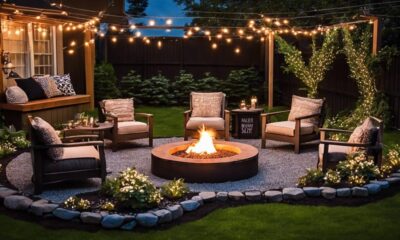Retreat
Incorporating Local Culture Into Your Retreat Center Design
Maximize guest experiences by integrating local culture into your retreat center design, but discover the secrets to doing it authentically and effectively.

Incorporating local culture into your retreat center design enhances guest experiences while connecting them to the community. Use authentic architectural styles and materials that reflect local traditions, as this creates a sense of place. Engaging local artisans for workshops and culinary experiences fosters deeper connections with the area's culture. It's important to avoid clichés by focusing on genuine representations that celebrate the community's complexities. By integrating local customs and sustainable practices, you not only attract eco-conscious clientele but also guarantee a memorable stay. As you explore these ideas, you'll uncover even more effective strategies to enhance your retreat's appeal.
Key Takeaways
- Collaborate with local artisans to integrate authentic cultural elements and craftsmanship into the retreat center's design.
- Engage local communities in storytelling to provide nuanced cultural representation and avoid clichés.
- Design communal spaces inspired by local customs to promote social interaction and a sense of belonging among guests.
- Incorporate sustainable materials sourced locally to reflect cultural identity and support the community's artisans.
- Offer hands-on workshops and culinary experiences that immerse guests in local traditions and enhance their overall experience.
Importance of Local Culture

Embracing local culture in retreat center design not only enhances the guest experience but also creates a unique atmosphere that resonates with visitors. When you integrate authentic cultural elements into your design, you tap into the rich traditions of the community, making your retreat a memorable destination.
Guests today increasingly seek experiences that reflect local culture, and by showcasing these traditions, you attract and retain clientele. Additionally, incorporating sustainable practices, such as using salvaged materials, can further enhance the authenticity of your center while reducing environmental impact. Utilizing locally sourced materials supports the community and fosters a deeper connection between guests and their surroundings.
This approach creates an immersive experience, allowing visitors to engage more meaningfully with the environment. Research shows that resorts reflecting local culture in their design receive higher satisfaction ratings from guests, leading to increased loyalty and repeat visits.
Incorporating cultural elements, like local artwork and traditional architecture, elevates the overall atmosphere of your retreat. This distinctiveness sets your center apart from competitors, making it not just a place to stay but a place to connect.
Design Strategies for Various Climates

Integrating local culture into your retreat center design sets the stage for considering how climate influences architecture and guest comfort.
In tropical climates, you'll want to focus on design strategies that include breezeways and natural landscaping features, which facilitate natural cooling and enhance guest privacy. This approach not only reflects local culture but also improves the overall guest experience.
Additionally, incorporating sustainable elements, such as a transformative composting system, can support local agricultural practices and minimize waste generated by the retreat center.
For a desert environment, consider architectural design that incorporates large overhangs and water elements. These features provide sun relief and create comfortable outdoor spaces where guests can relax while staying connected to nature.
If your retreat center is in a mountainous region, take snowfall into account. Sloped roofs and insulated materials will help your center withstand harsh weather, ensuring safety and comfort for your guests.
Across all climates, effective landscape integration is essential. By incorporating local environmental features, such as natural vegetation and topography, you enhance both the aesthetic appeal and functionality of your retreat center.
This thoughtful design not only promotes privacy and outdoor activity areas but also fosters a deeper connection to the surrounding landscape, enriching the guest experience.
Avoiding Cultural Clichés

Cultural authenticity is essential in retreat center design, as it helps avoid the pitfalls of stereotypes and clichés. To achieve this, focus on genuine cultural representation that reflects local traditions and values.
Engaging local communities in the storytelling process not only guarantees a nuanced portrayal of their culture but also enhances content relevance and authority. This approach fosters emotional connections between guests and the space, creating a design identity that resonates deeply.
Utilizing storytelling as a foundational element allows you to anchor your design in local culture while avoiding oversimplification. By embracing the cultural complexities of the area, you can create a richer experience that celebrates uniqueness rather than relying on generic representations.
Collaborating with local artisans and craftsmen not only enhances authenticity but also supports the local economy, reinforcing the cultural narrative.
Engaging Local Communities

Often, retreat centers that actively engage local communities create a deeper, more meaningful experience for visitors. By collaborating with local artisans and craftsmen, you can incorporate traditional design elements that enhance cultural authenticity, such as incorporating Asian-inspired elements that promote tranquility. This not only enriches the aesthetic of your retreat but also honors the skills and heritage of local artisans.
Understanding and integrating local customs and practices into your offerings can provide an immersive experience that respects the community's way of life. Consider offering opportunities for community service or volunteerism, which can strengthen ties between your retreat and local communities while promoting sustainable tourism. This approach fosters reciprocal interactions that benefit both visitors and residents.
Building relationships with local businesses guarantees that your retreat supports the economy in a responsible way, encouraging cultural exchange and enriching your guests' experience.
You'll find that engaging with local communities not only enhances the retreat's ambiance but also creates a space where visitors can connect with the culture on a personal level. Ultimately, this engagement cultivates a sense of belonging, making your retreat center a unique and cherished destination for all involved.
Enhancing Guest Experiences

To enhance your guests' experiences, integrating authentic cultural elements into your retreat center can make all the difference.
Incorporating symbols that represent Polynesian symbols for strength or local heritage can resonate deeply with visitors, allowing them to appreciate the richness of the culture.
When guests connect with local traditions and narratives, they create memorable experiences that go beyond standard amenities.
Offering unique activities, like workshops with local artisans, can transform their stay into something truly special.
Authentic Cultural Elements
When you step into a retreat center that celebrates authentic cultural elements, you immediately feel a connection to the local environment and its heritage. This authentic cultural representation enhances your overall experience and satisfaction, as you engage with the rich tapestry of the area.
Incorporating locally sourced materials and traditional craftsmanship creates unique aesthetic elements that resonate with the cultural heritage around you. For instance, utilizing natural materials like wood and stone not only aligns with modern farmhouse decor trends but also reflects the local landscape and traditions.
Engaging local artists and craftsmen in the design process not only enriches the cultural authenticity of the retreat but also supports community development. This collaboration fosters a sense of pride and ownership, enhancing your immersive experience.
Storytelling through design elements, like murals inspired by local legends, invites you to appreciate the narrative behind the space.
Balancing modern amenities with these authentic cultural features attracts a diverse clientele seeking unique experiences. You'll find yourself immersed in the local culture, feeling the heartbeat of the community.
Memorable Local Experiences
There's something special about immersing yourself in local traditions and cultural practices during your retreat. It enhances your experience, allowing you to forge authentic connections with the community and the rich heritage surrounding you.
Incorporating local culinary experiences, such as enjoying high-protein breakfast options at places like the Cedar Key Bed and Breakfast, can further enrich your stay.
Here are three ways to incorporate memorable local experiences into your retreat:
- Workshops: Engage in hands-on learning by participating in workshops led by local artisans. This fosters memorable interactions and a deeper appreciation for traditional practices.
- Culinary Experiences: Enjoy farm-to-table meals or cooking classes that highlight local flavors. These culinary experiences not only satisfy your palate but also offer insight into the local culture.
- Unique Excursions: Explore regional landmarks and natural wonders through curated excursions. These adventures create lasting memories while promoting a sense of exploration and connection to the area's artistic talents.
Architectural Inspirations

Architectural inspirations for retreat centers seamlessly blend local culture and natural surroundings, creating spaces that resonate with your experiences. Incorporating traditional architectural designs is crucial for fostering an authentic environment that enhances your overall experience.
Consider how local materials and building techniques support regional craftsmanship while establishing a deeper connection between you and the landscape. By leveraging innovative design solutions, architects can create spaces that not only reflect cultural heritage but also promote sustainability and functionality.
Your retreat center's layout can draw inspiration from local styles—think open-air pavilions in tropical settings or adobe structures in arid regions. Such designs promote harmony with the natural environment, making your stay even more immersive.
Thoughtful space planning is essential, too; communal areas inspired by local customs encourage social interaction and shared experiences among participants, enriching your time there.
Additionally, framing natural vistas and significant cultural landmarks within the architecture not only elevates aesthetic appeal but also provides a unique sense of place. This approach invites you to engage more deeply with the surroundings, enhancing both relaxation and reflection.
Sustainable Material Sourcing
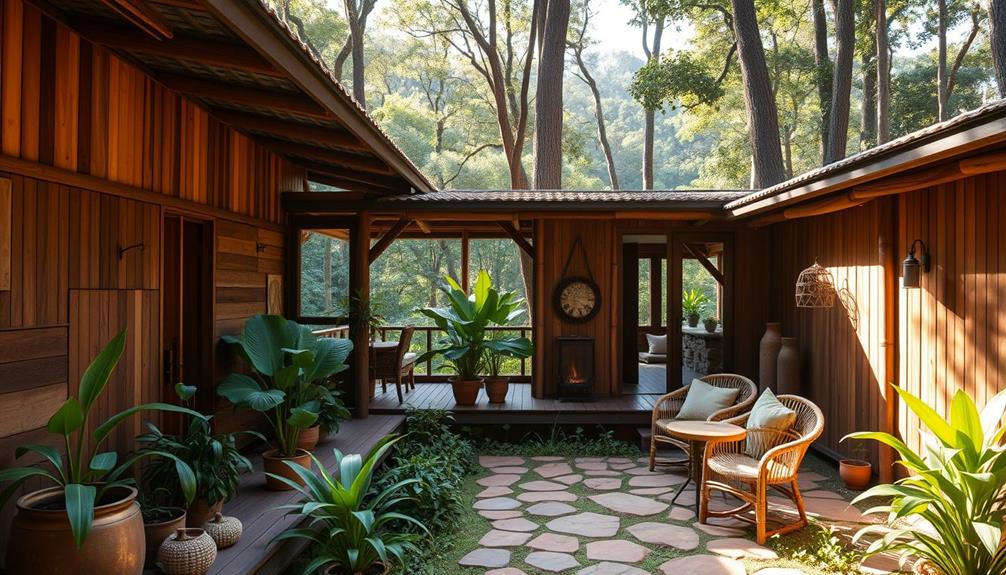
Sustainable material sourcing plays an essential role in designing a retreat center that harmonizes with both the environment and the local community. By choosing sustainable materials, you not only lower your environmental impact but also foster community relationships that are critical for the center's success.
For instance, incorporating eco-friendly options like horse wood pellet bedding can enhance the center's sustainability efforts while supporting local industries.
Here are three key benefits of sourcing materials locally:
- Reduced Carbon Footprint: Utilizing renewable resources, like reclaimed wood and bamboo, cuts down on transportation emissions, promoting eco-friendly practices.
- Cultural Reflection: Locally sourced materials can mirror the region's architecture and craftsmanship, enhancing the retreat's aesthetic while celebrating the area's cultural identity.
- Support for Local Artisans: Engaging local artisans in the design process guarantees that the retreat authentically represents the surrounding community, creating a richer, more authentic experience for guests.
Creating Memorable Experiences
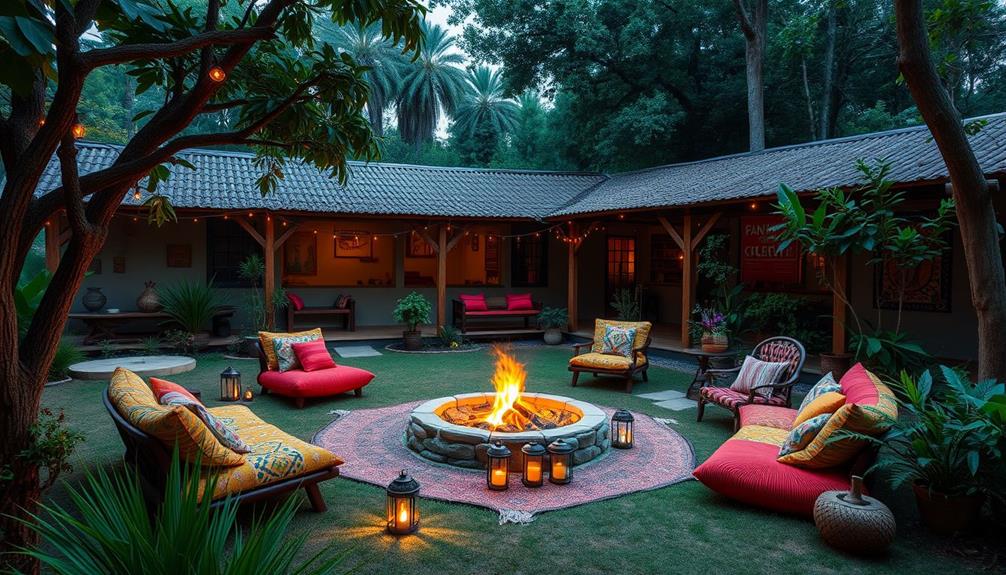
Designing a retreat center with sustainable materials sets the stage for creating unforgettable experiences that resonate with guests. When you integrate local culture into your retreat design, you foster deeper connections between participants and their surroundings. This approach cultivates memorable experiences that enhance personal identity and satisfaction.
Additionally, incorporating energy-efficient systems, like the best heat pumps, can contribute to a more sustainable environment while providing superior comfort for guests energy-saving features. Emphasizing community engagement allows for authentic experiences that go beyond the ordinary. By avoiding clichés and showcasing real cultural representation, you create unique interactions that leave a lasting impact. Research shows that these experiences are valued more over time than material goods, highlighting their importance.
Incorporating hands-on workshops that reflect local traditions brings transformational experiences to life. Guests not only learn new skills but also engage directly with the community, supporting and uplifting it in the process. These enriching activities encourage participants to immerse themselves in the culture, creating bonds that transcend their stay.
Ultimately, your retreat center can become a hub for meaningful experiences, where guests connect with the local culture and each other, leaving with memories that last a lifetime. By focusing on these elements, you'll guarantee that your retreat center stands out in a crowded market.
Commercial Success Factors
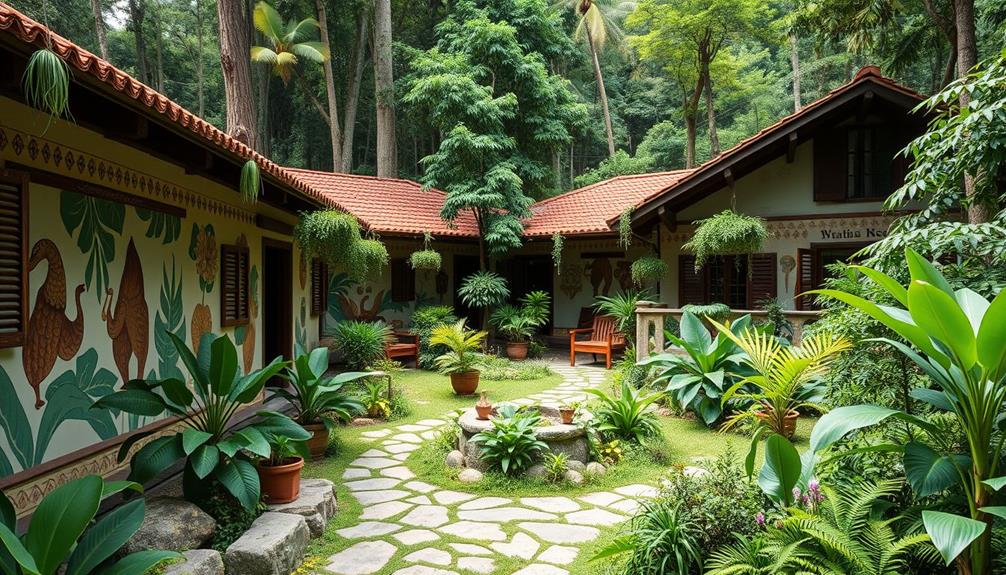
While creating a retreat center, focusing on commercial success factors is essential for attracting and retaining guests.
By integrating local culture into your design, you can stand out in a competitive market. Here are three key factors to take into account:
- Unique Architectural Styles: Embrace local heritage in your architectural choices. This not only enriches the aesthetic appeal but also helps create a memorable identity for your retreat center.
- Authentic Experiences: Offer guests compelling experiences that resonate with local traditions. These authentic experiences lead to higher guest satisfaction, encouraging repeat visits and positive word-of-mouth referrals.
- Strong Brand Identity: Root your brand identity in local culture. This strengthens your marketability, especially among eco-conscious clientele who value cultural heritage and authenticity.
Future Trends in Retreat Design

As retreat centers evolve, several key trends are shaping their future, particularly in how they connect with guests and the environment. A commitment to sustainability is at the forefront, with eco-friendly practices and locally sourced materials minimizing environmental impact while promoting harmony with natural surroundings.
Immersive experiences that reflect local culture are becoming increasingly popular. These experiences engage guests and deepen their connection to the area's cultural authenticity. Technological integration is also on the rise, enhancing guest interactions through smart technology for convenience and personalized experiences.
Wellness remains a priority in retreat design, focusing on natural light, open spaces, and access to nature to foster relaxation. Collaboration with local artists and craftsmen enriches the experience through the inclusion of indigenous art and architecture, supporting the local economy.
| Trend | Description |
|---|---|
| Sustainability | Utilizing eco-friendly practices and materials |
| Immersive Experiences | Connecting guests with local culture |
| Technological Integration | Enhancing interactions through smart tech |
These trends illustrate a future where retreat centers not only offer relaxation but also a meaningful connection to the environment and local culture.
Frequently Asked Questions
How Can We Measure the Impact of Local Culture on Retreat Participants?
You can measure local culture's impact on retreat participants by gathering feedback through surveys, observing interactions, and analyzing emotional responses. Engaging participants in discussions about their experiences will provide valuable insights into cultural influence.
What Are Effective Ways to Collaborate With Local Artists and Artisans?
You'll find inspiration in vibrant murals yet appreciate the delicate craftsmanship of local artisans. Collaborate by hosting workshops, supporting art shows, and commissioning pieces, enriching your space while fostering community connections that resonate deeply with participants.
How Do We Ensure Cultural Sensitivity in Our Retreat Offerings?
You guarantee cultural sensitivity by actively engaging with local communities, listening to their needs, and respecting traditions. It's crucial to educate yourself and your team, fostering open dialogue to create an inclusive, respectful environment for everyone.
What Types of Local Traditions Can Be Incorporated Into Retreat Activities?
Did you know 78% of travelers seek authentic experiences? You can incorporate local traditions like storytelling sessions, traditional cooking classes, or community dances, enriching your retreat while fostering connections between participants and the local culture.
How Can We Promote Local Culture Without Appropriating It?
To promote local culture without appropriating it, you should engage with community members, collaborate on events, and prioritize education. Highlight authentic stories and practices, ensuring respect and representation while celebrating the richness of their traditions.
Conclusion
Incorporating local culture into your retreat center design not only enriches the guest experience but also fosters a deeper connection with the surrounding community. Did you know that properties that embrace local culture see a 20% increase in guest satisfaction? By engaging local traditions, sourcing sustainable materials, and creating memorable experiences, you can guarantee your retreat stands out while promoting cultural appreciation. Embrace these elements, and you'll not only attract guests but also contribute positively to the local environment.
- About the Author
- Latest Posts
Introducing Ron, the home decor aficionado at ByRetreat, whose passion for creating beautiful and inviting spaces is at the heart of his work. With his deep knowledge of home decor and his innate sense of style, Ron brings a wealth of expertise and a keen eye for detail to the ByRetreat team.
Ron’s love for home decor goes beyond aesthetics; he understands that our surroundings play a significant role in our overall well-being and productivity. With this in mind, Ron is dedicated to transforming remote workspaces into havens of comfort, functionality, and beauty.
Retreat
The Art of Feng Shui in Retreat Center Layout
Breathe new life into your retreat center layout with Feng Shui principles that enhance energy flow—discover the secrets to creating a truly inviting space.
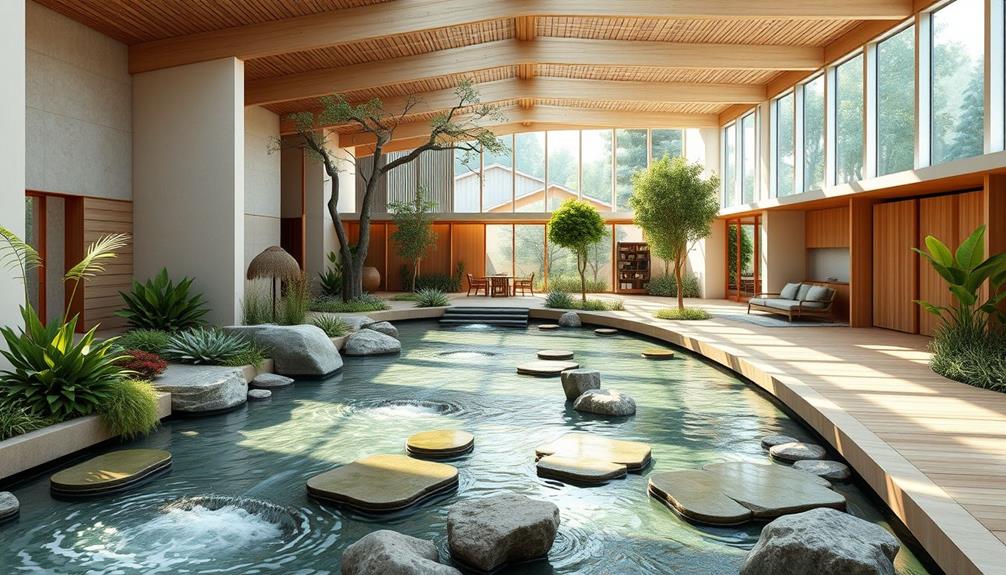
The art of Feng Shui in retreat center layout is all about enhancing the flow of energy, known as chi, to create peaceful and inviting spaces. You can use the Bagua map to balance nine key areas of life, like health and relationships. Focus on the Commanding Position to guarantee guests feel secure and at ease. Incorporating natural elements, such as plants and water features, fosters tranquility. Curved pathways promote a smooth energy flow, while unique personal touches elevate the experience. If you explore further, you'll discover even more ways to enrich your retreat environment.
Key Takeaways
- Ensure a harmonious energy flow by utilizing the Bagua map to evaluate and enhance different areas of the retreat center.
- Incorporate natural elements like plants and water features to create a calming atmosphere and connect guests to nature.
- Position key areas in the Commanding Position, allowing guests to observe the entrance and feel secure during their stay.
- Create inviting social spaces with cozy seating arrangements and soft lighting to foster connection and relaxation among participants.
- Regularly review and adjust the layout to maintain vibrant energy aligned with the retreat's purpose and guest needs.
Understanding Feng Shui Principles

Understanding Feng Shui principles is essential for creating a harmonious environment in a retreat center. At the heart of these principles is the concept of Chi, or the flow of energy, which plays a significant role in promoting well-being. By ensuring that spaces are balanced and open, you can enhance the flow of energy, making your retreat feel more inviting and serene.
Embracing a mindset of nurturing an imaginative mindset can further enhance the design process, allowing for a more creative integration of these principles.
To achieve this, thoughtfully integrate the five elements of Feng Shui—water, earth, fire, wood, and metal—into your center's layout. Each element contributes to the overall ambiance, fostering a tranquil atmosphere that supports healing and reflection. For instance, incorporating natural elements like plants and water features can boost the sense of calm and connection to nature.
Additionally, creating a Commanding Position in your design allows guests to feel secure and in control. This promotes relaxation and rejuvenation, essential for any retreat experience.
Utilizing the Bagua Map

When you incorporate the Bagua map into your retreat center layout, you create a powerful tool for enhancing specific areas of life. The Bagua divides your space into nine sections, each linked to different aspects like wealth, health, and relationships.
Start by evaluating your layout to identify areas that may be lacking; these can be compensated by integrating elements from other sections, ensuring a balanced energy flow.
For example, in the southeast Wealth area, adding plants and water features can considerably boost positive energy. Meanwhile, the southwest Love area flourishes with soft, romantic colors and decor.
By placing key symbols, like the Laughing Buddha in the northeast Knowledge area, you invite abundance and wisdom into your center.
Regularly reviewing your retreat center's layout using the Bagua map is essential. This practice helps maintain vibrant energy that aligns with your center's purpose, creating an environment where guests can relax and rejuvenate.
The Commanding Position
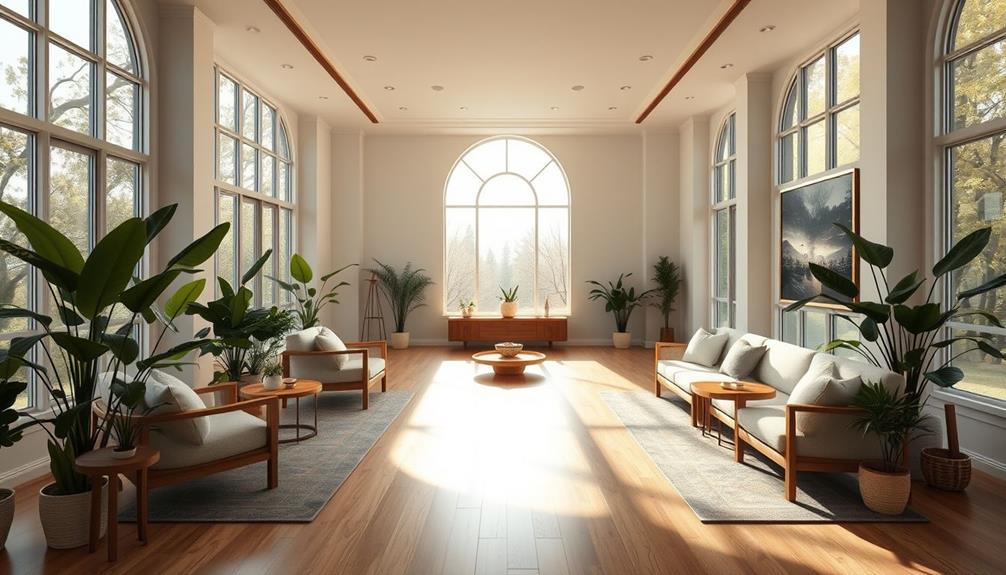
A well-placed Commanding Position can dramatically enhance the energy and atmosphere of your retreat center. By strategically positioning key elements—like seating or focal points—you create a space where individuals can observe the entrance while feeling secure and in control. This arrangement is crucial for areas such as relaxation zones or meeting spaces, fostering a sense of safety and openness among participants.
Insights from philosophical exploration can further illuminate the significance of creating environments that promote personal reflection and growth.
To achieve the ideal Commanding Position, place seating diagonally across from the entrance. This allows for a clear view of incoming energy without being directly aligned with the door, striking a balance between awareness and comfort. When you incorporate this design principle, you encourage positive energy flow (chi), which is essential for transformative experiences during retreats.
You can further enhance the effectiveness of the Commanding Position by creating defined boundaries using natural elements like plants or thoughtful furniture arrangements. These adjustments not only support the overall layout but also cultivate a welcoming atmosphere that invites engagement and connection.
Creating Restful Spaces

Creating restful spaces in your retreat center is essential for fostering relaxation and rejuvenation. To achieve this, incorporate natural elements like plants and water features, as they enhance tranquility and align with Feng Shui principles.
Consider adding a DIY Fire Pit Ideas to create a cozy gathering spot that complements the serene atmosphere. These elements promote a calming ambiance that supports well-being.
When arranging furniture in comfortable seating areas, follow the Commanding Position. This allows users to enjoy views and feel secure, contributing to relaxation and encouraging social interaction.
Additionally, utilizing soft, warm lighting—like string lights or lanterns—creates inviting environments that uplift moods and foster a sense of peace, vital for restful spaces.
Pay attention to the strategic arrangement of pathways and defined boundaries, such as pebble paths. Curved walkways are particularly effective, guiding the flow of chi and enhancing relaxation through smoother energy movement.
Enhancing Outdoor Ambiance
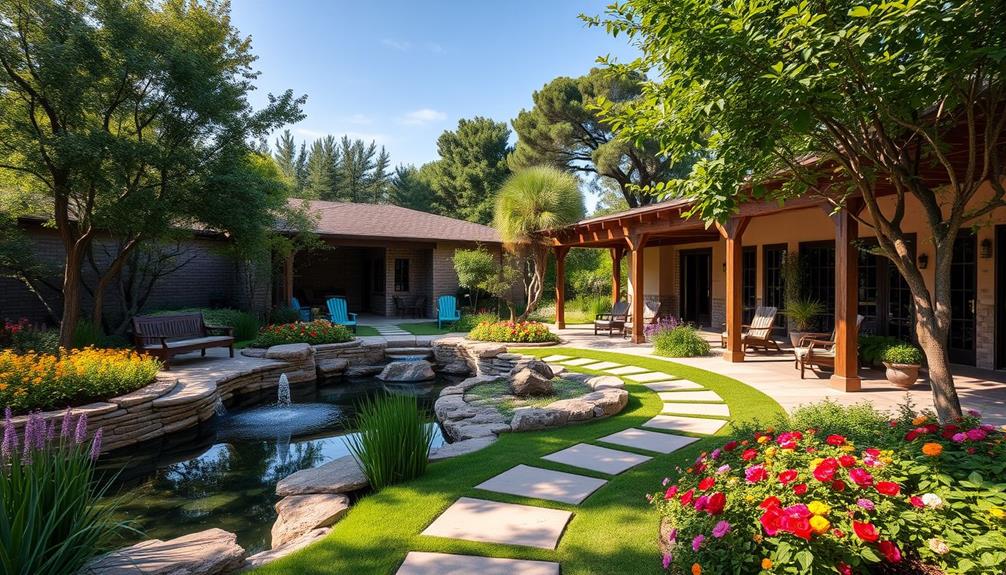
To enhance the outdoor ambiance of your retreat center, think about the strategic placement of elements that resonate with the energy you want to attract.
Consider incorporating features that align with your surroundings, such as natural landscaping or elements that reflect the unique camping experiences available in nature.
Integrating natural lighting won't only brighten the space but also uplift spirits, while personal touches in decor can make the area feel uniquely yours.
Strategic Element Placement
While designing the outdoor spaces of a retreat center, strategic element placement plays a crucial role in enhancing the ambiance and energy flow. By aligning your garden art and features with the Bagua map, you can guarantee ideal chi movement and create a harmonious outdoor space.
Incorporating water features, like fountains or ponds, not only symbolizes abundance and prosperity but also introduces soothing sounds that elevate the environment's tranquility. Additionally, integrating modern farmhouse decor trends can infuse rustic charm into the outdoor setting, creating a serene yet stylish atmosphere.
Utilizing the Commanding Position for seating areas—think fire pits or lounges—allows guests to observe their surroundings, fostering a welcoming atmosphere. Consider curved pathways made from natural materials such as pebbles or wood; these promote smoother energy flow compared to straight paths, enhancing the overall ambiance of your retreat center.
Don't forget to add personal touches, like seasonal decorations and meaningful artifacts. These elements not only reflect individual style but also keep the outdoor space dynamic and engaging, promoting positive energy.
Natural Lighting Integration
Natural lighting is essential for transforming outdoor spaces into serene retreats that foster connection with nature. By strategically positioning your outdoor seating areas, you can maximize exposure to natural lighting throughout the day. This encourages relaxation and social interaction among guests, enhancing their overall mood.
Incorporating plants that thrive in bright light, such as the best soil for String of Hearts plants, can also contribute to a more vibrant atmosphere.
To create a warm and inviting atmosphere for evening events, consider incorporating outdoor lighting fixtures like solar-powered lanterns and string lights. These not only illuminate the space but also align with the principles of Feng Shui, promoting harmony and balance.
Utilizing reflective surfaces, such as water features or mirrors, can greatly amplify natural light, making your outdoor area feel brighter and more energizing.
Surround these lighting sources with lush greenery and plant life to enhance the interplay of light and shadow. This dynamic visual experience not only captivates the senses but also supports the calming ambiance essential for a retreat center.
Personal Touches Artistry
Creating an enchanting outdoor ambiance involves incorporating personal touches that resonate with your style and align with Feng Shui principles. When you enhance your retreat space with unique garden art or sculptures that follow the Bagua map, you promote the flow of life energy, creating an environment ripe for relaxation and tranquility.
Consider using seasonal decorations and meaningful artifacts that you can rotate, keeping your space dynamic and fresh. Natural materials like wood and stone for outdoor furniture foster a connection with nature, enhancing both aesthetics and positive energy. Thoughtfully positioned light sources, such as soft string lights or lanterns, create an inviting atmosphere while guiding chi flow during evening gatherings.
To help visualize these elements, take a look at the table below:
| Element | Description |
|---|---|
| Garden Art | Unique pieces that reflect style |
| Seasonal Decor | Rotating artifacts for freshness |
| Natural Materials | Wood and stone furnishings |
| Light Sources | Soft string lights and lanterns |
| Sound Elements | Wind chimes and water features |
Incorporating Water Features
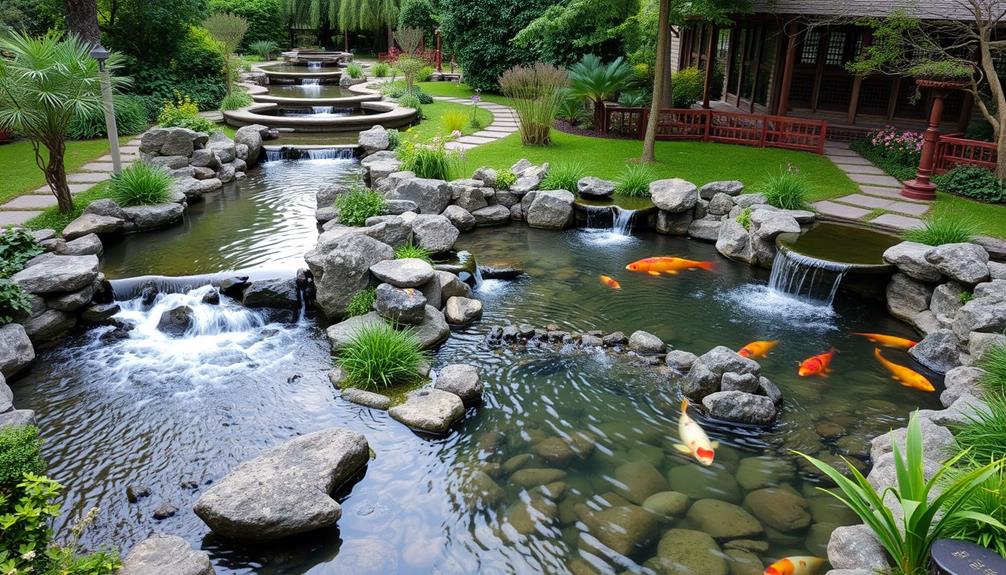
Incorporating water features into your retreat center layout can considerably enhance the space's energy and ambiance. Water features symbolize abundance and prosperity, aligning perfectly with Feng Shui principles that prioritize the flow of chi. By strategically placing elements like fountains or ponds in the southeast area of the Shui Bagua, you can attract wealth and financial opportunities, making your retreat design more impactful.
Additionally, integrating aspects like thrilling adventures at DFW Water Parks can inspire a sense of joy and connection to water, further enriching the experience.
The soothing sound of flowing water contributes to a calming atmosphere, helping to reduce stress and promote relaxation among participants. This serene environment is essential for creating a rejuvenating experience. Reflective water surfaces not only amplify positive energy but also serve as visual focal points, inviting contemplation and enhancing the overall tranquility of the space.
However, regular maintenance of these water features is vital. Stagnant or neglected water can lead to negative energy accumulation, undermining the intended benefits of Feng Shui in your retreat environment.
Defining Boundaries and Flow

Defining boundaries and movement in your retreat center layout is essential for fostering a harmonious environment. Clear boundaries, like pebble paths or natural fencing, guide the flow of chi, creating a sense of security and containment within the space.
Cultivating a sense of curiosity about the arrangement of natural elements can enhance your design process, leading to enhanced cognitive flexibility and improved decision-making. You'll find that curved walkways are more effective than straight paths, as they facilitate smoother energy movement, promoting a tranquil atmosphere for your guests.
Pay attention to the Commanding Position for key areas, such as relaxation zones or gathering spaces. This positioning allows individuals to observe their surroundings while feeling safe and secure. Incorporating natural elements, like plants and water features, enhances the flow of energy, making shifts between different sections of the retreat center feel inviting.
Regularly assess and adjust your layout according to the Bagua map. This practice guarantees that all areas of your retreat center support specific intentions, enhancing the overall energy and purpose of the space.
Personalizing the Retreat Experience

A personalized retreat experience can greatly enhance the overall atmosphere and satisfaction of your guests. By incorporating individual elements that resonate with attendees, like art and decor reflecting their preferences and cultural backgrounds, you'll deepen their connection to the space.
Utilizing the Bagua map in your retreat center layout allows you to strategically place personal items and symbols that promote positive energy flow, enriching their experience. This approach aligns with the principles of the power of imagination, as it encourages guests to envision their ideal retreat experience, fostering a transformative atmosphere.
Creating comfortable rest areas with natural fabrics and earthy tones tailored to your guests' tastes fosters relaxation, encouraging a sense of belonging. Including personalized wellness options, such as aromatherapy or customized activity schedules, enhances individual experiences and supports mental and emotional well-being.
Seasonal decorations and meaningful artifacts keep the retreat dynamic and engaging, ensuring that returning guests feel a renewed sense of connection with the space.
This emphasis on personalization not only transforms your retreat into a sanctuary of comfort and peace but also embodies the art of Feng Shui, harmonizing your environment with the needs of those who inhabit it. By prioritizing these elements, you create an unforgettable experience that resonates long after your guests leave.
Frequently Asked Questions
How Can I Choose a Suitable Location for My Retreat Center?
To choose a suitable location for your retreat center, consider accessibility, natural surroundings, local amenities, and the atmosphere. You want a peaceful environment that aligns with your vision and meets your guests' needs effectively.
What Role Does Color Play in Feng Shui Design for Retreats?
Imagine walking into a room painted in calming blues; it instantly soothes your mind. In feng shui, colors influence energy flow, enhancing tranquility or creativity—choose wisely to create the perfect atmosphere for your retreat.
Are There Specific Plants Recommended for Enhancing Feng Shui?
Yes, certain plants are recommended to enhance feng shui. Consider adding bamboo for flexibility, jade plants for prosperity, and peace lilies for tranquility. These plants not only improve energy flow but also create a serene atmosphere.
How Do Seasonal Changes Affect Feng Shui in Retreat Centers?
Seasonal changes impact feng shui by influencing energy flow. You can adjust your space with seasonal decor, colors, and scents to align with nature, enhancing harmony and promoting well-being for everyone who visits.
Can Feng Shui Improve the Overall Staff Experience at the Retreat?
Imagine a retreat where staff feels energized and connected. By incorporating feng shui principles, you can enhance their workspace, promote harmony, and boost morale, ultimately improving their overall experience and productivity within the center.
Conclusion
Incorporating feng shui into your retreat center layout can transform the entire experience for your guests. By focusing on balance, flow, and natural elements, you create a space that fosters relaxation and rejuvenation. Have you considered how small adjustments can lead to profound changes in energy and ambiance? Embracing these principles not only enhances the physical environment but also enriches the soul, ensuring every visitor leaves feeling harmonized and inspired.
- About the Author
- Latest Posts
Introducing Ron, the home decor aficionado at ByRetreat, whose passion for creating beautiful and inviting spaces is at the heart of his work. With his deep knowledge of home decor and his innate sense of style, Ron brings a wealth of expertise and a keen eye for detail to the ByRetreat team.
Ron’s love for home decor goes beyond aesthetics; he understands that our surroundings play a significant role in our overall well-being and productivity. With this in mind, Ron is dedicated to transforming remote workspaces into havens of comfort, functionality, and beauty.
Retreat
How to Design an Accessible Retreat Center for All Abilities
Navigate the essentials of creating an inclusive retreat center for all abilities, and discover key strategies that ensure everyone feels welcome and included.
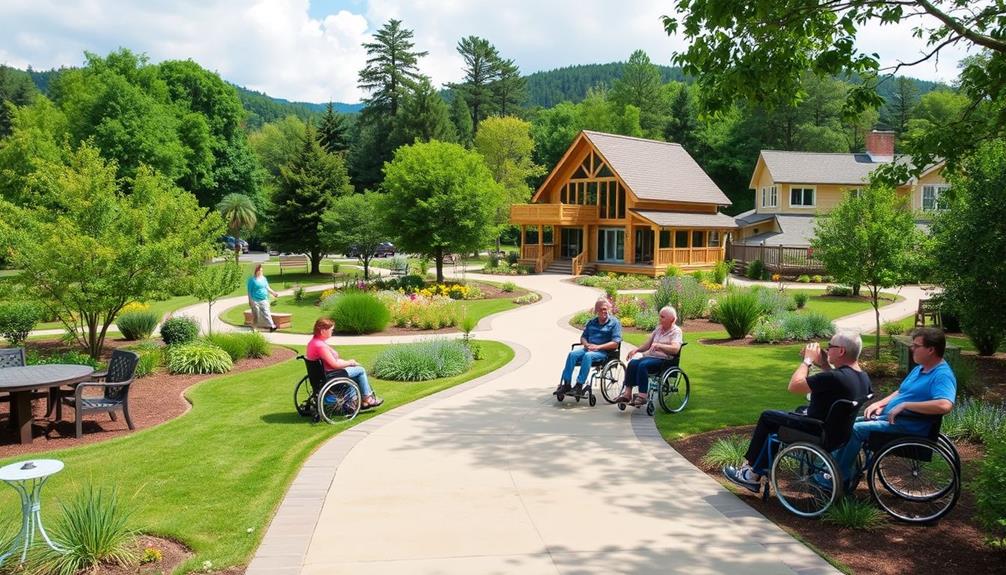
To design an accessible retreat center, think inclusivity from the start. Guarantee clear signage, smooth pathways, and wide doorways for mobility. Incorporate sensory-friendly spaces with proper lighting and soundproofing. Consult individuals with disabilities during the planning process to gather valuable insights. Make certain your venue follows ADA standards, including accessible restrooms and parking. Provide activities that cater to various abilities, like seated yoga or guided nature walks. Training staff in sensitivity and ADA compliance is also essential. By prioritizing these elements, you'll create an inviting environment for everyone, and there's more to explore on this topic.
Key Takeaways
- Incorporate universal design principles to ensure spaces are usable for individuals of all abilities from the outset.
- Include essential physical accessibility features such as ramps, elevators, and accessible restrooms to facilitate navigation.
- Implement clear signage with large fonts and high-contrast colors to assist individuals with visual impairments.
- Create sensory-friendly spaces with proper lighting and soundproofing to accommodate diverse sensory needs.
- Plan inclusive activities that cater to various abilities, offering non-strenuous options like seated yoga and guided discussions.
Understanding Accessibility in Design

When you think about designing an accessible retreat center, it's vital to understand that accessibility goes beyond just physical access. It's about creating an environment that accommodates the diverse needs of all individuals.
Universal Design plays an important role here, guaranteeing that spaces are usable for everyone, not just those with disabilities. Incorporating natural materials and a neutral color palette, similar to modern farmhouse decor trends, can create a welcoming environment that feels inclusive.
To achieve this, you should focus on key elements like clear signage, smooth pathways, and accessible facilities. These features not only comply with the Americans with Disabilities Act (ADA) but also enhance the experience for all guests. For example, incorporating sensory-responsive elements, such as Braille signage and auditory signals, can greatly benefit individuals with visual and hearing impairments.
Moreover, a thorough accessibility plan requires you to consult with individuals who've disabilities. By integrating their perspectives and needs into the design process, you'll make informed decisions that truly enhance accessibility.
Key Principles of Inclusive Design
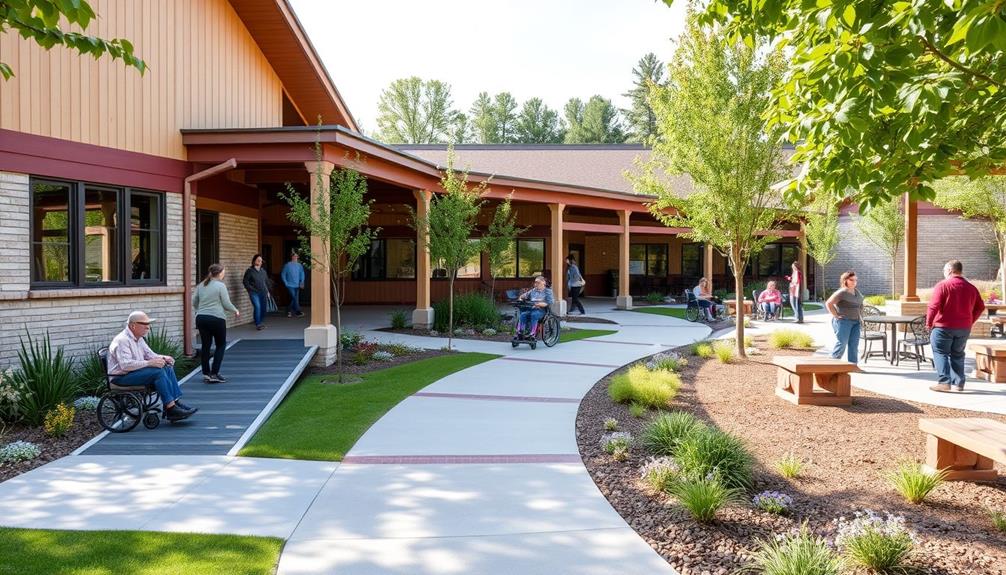
When designing your retreat center, think about holistic space design that accommodates users with diverse needs.
Consider how accessible pathways, ramps, and sensory features can enhance everyone's experience.
It's also important to incorporate elements that promote financial stability for your center, ensuring you can sustain its operation over time, which can be achieved through effective budgeting strategies.
Holistic Space Design
Creating a holistic space design means prioritizing inclusivity from the very beginning. By integrating accessibility features into your retreat center's layout, you guarantee that everyone feels welcome and can fully engage in activities. Key principles include physical, sensory, and cognitive accessibility, all designed to enhance the user experience.
| Principle | Description | Benefits |
|---|---|---|
| Physical Accessibility | Ramps and wide doorways for easy navigation | Guarantees everyone can enter and move freely |
| Sensory Accessibility | Clear signage and auditory signals | Helps individuals with diverse needs orient themselves |
| Cognitive Accessibility | Intuitive layouts and tranquil spaces | Supports comfort and ease of navigation |
| Universal Design | Principles that benefit all individuals | Increases participation and enjoyment |
| Innovative Technology | Wayfinding apps and automated systems | Enhances adaptability and user-friendliness |
Incorporating these elements into your retreat center creates accessible facilities that foster inclusivity. By focusing on holistic space design, you'll create an inviting environment that meets the needs of all participants, guaranteeing everyone enjoys their experience.
Diverse User Considerations
Designing a retreat center that truly welcomes everyone means considering the diverse needs of all users. To create an inclusive environment, focus on principles that prioritize accessibility. This includes ensuring entrances are easily navigable and pathways are smooth, allowing individuals with disabilities to move freely without barriers.
Additionally, incorporating design thinking principles can enhance the overall user experience by aligning the design with the needs of all visitors.
Implement clear signage throughout the space, using large fonts and high-contrast colors to assist those with visual impairments. Incorporating assistive technologies, like auditory signals and Braille signage, will further enhance the experience, enabling all visitors to navigate independently and confidently.
Engaging individuals with disabilities during the design process is vital. Their input provides valuable insights into their unique needs, leading to more effective solutions.
Remember, universal design benefits everyone, not just those with disabilities. By creating spaces that accommodate a wide range of abilities, you promote social equity and encourage community engagement.
Ultimately, your goal is to foster an environment where everyone feels included and valued. By embracing these diverse user considerations, you'll create a retreat center that truly embodies the spirit of accessibility and inclusivity for all.
Importance of Accessibility for Retreats

Accessibility in retreat centers is essential for ensuring that everyone, regardless of their abilities, can participate fully in wellness activities. By prioritizing accessibility from the beginning, you comply with the Americans with Disabilities Act (ADA), which mandates equal access for individuals with disabilities in public accommodations.
This commitment goes beyond physical challenges; it also addresses sensory and cognitive needs, allowing all participants to engage without barriers. Additionally, fostering an environment of curiosity and happiness can enhance the retreat experience, as individuals feel more inclined to explore and engage with new perspectives.
When you create inclusive environments, you foster a sense of belonging and community, enhancing the overall experience for everyone involved. Research demonstrates that accessible retreats can attract a wider audience, boosting participation and revenue potential while cultivating a culture of inclusivity and diversity.
Implementing universal design principles benefits everyone—not just those with disabilities. By making spaces user-friendly, you improve the overall guest experience, making it enjoyable for all attendees.
Ultimately, prioritizing accessibility isn't just about compliance; it's about enriching the retreat experience and ensuring that everyone feels welcomed and valued. So, take the necessary steps to create an accessible retreat center, and you'll set the stage for meaningful connections and transformative experiences for all.
Selecting an Accessible Location
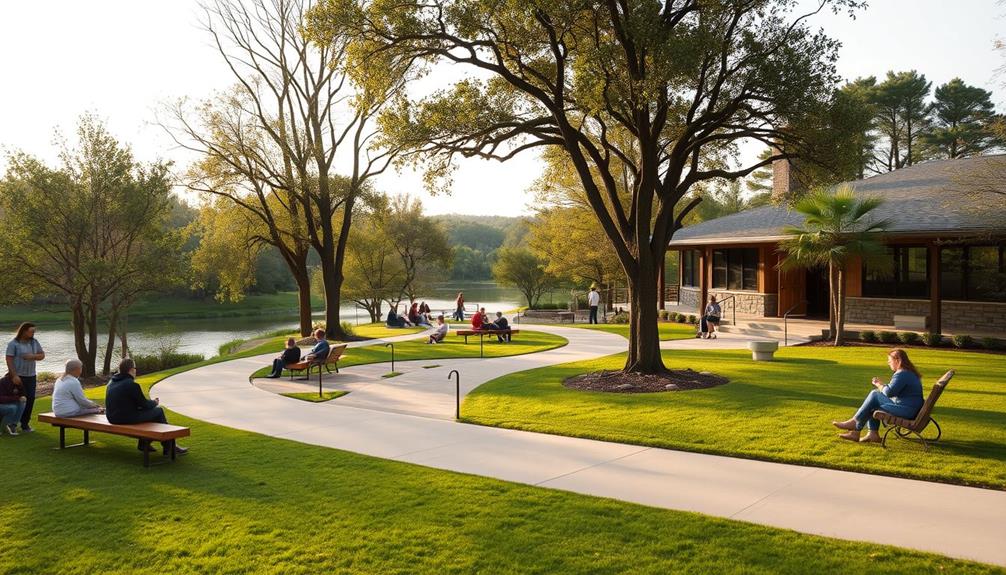
When you're selecting an accessible location for your retreat center, it's crucial to prioritize venues with features that meet ADA standards, like ramps and accessible restrooms.
Additionally, consider the potential costs associated with accessibility modifications to guarantee that all attendees can participate comfortably.
It's also important to review available resources for financial considerations for elderly care to help support the needs of participants.
Consider transportation options to make certain attendees can easily reach the site without added stress.
Thoroughly evaluate the area for potential hazards and accessibility features to create a welcoming environment for everyone.
Venue Accessibility Features
Choosing an accessible location for your retreat center is essential to guarantee everyone can participate fully. Start by prioritizing venues that comply with the Americans with Disabilities Act (ADA). This assures equal access for all, especially for those using mobility aids.
Look for features like wheelchair ramps, elevators, and wide doorways to make navigation easy for everyone. Additionally, it's important to select spaces that consider sensory needs, as creating an inclusive environment can greatly enhance the experience for all attendees, including those who may benefit from natural remedies alongside medications.
Accessible parking is another critical aspect. Make sure the venue has dedicated spaces close to the entrance, which will ease travel for attendees with mobility challenges.
Also, check for accessible restrooms equipped with clear signage, ensuring they're well maintained and easy to locate.
Consider offering sensory-friendly spaces for those who may need them. Accommodations such as assistive listening devices and visual aids can help create an inclusive environment for all participants.
By focusing on these venue accessibility features, you can enhance the experience for everyone involved, fostering a welcoming atmosphere that encourages participation and engagement.
Transportation Considerations
Selecting a retreat center in a location with accessible transportation options is vital for guaranteeing all participants can join without hassle. Start by choosing a center near accessible public transportation routes, allowing individuals with varying mobility needs to reach the venue easily.
Check that these routes are free of barriers like stairs and have smooth surfaces suitable for wheelchair users. Moreover, consider the potential for nearby attractions, such as hotels with water parks, that may enhance the overall experience for attendees, providing them with additional leisure options after the retreat best hotels with water parks.
Additionally, confirm that any transportation services you provide, such as shuttles or vans, include wheelchair-accessible vehicles. This guarantees that all guests can travel comfortably and safely.
It's also important to evaluate the parking facilities at your retreat center. Make sure there are designated accessible parking spaces conveniently located near the entrance, minimizing the distance that individuals with mobility challenges must walk.
Lastly, consider collaborating with local transportation providers to set up reliable options for attendees requiring special assistance. Pre-arranged transport can be invaluable for those with specific needs, guaranteeing everyone feels welcome and included.
Designing for Diverse Abilities

Designing for diverse abilities means guaranteeing that everyone can navigate and enjoy your retreat center comfortably. You'll want to incorporate various accessible features, such as ramps, wide doorways, and elevators, to facilitate smooth movement for individuals with mobility devices. Additionally, reflect on designing sensory-friendly spaces with appropriate lighting and soundproofing, along with signage in Braille for those with visual or hearing impairments.
Here's a quick overview of essential features to reflect on:
| Accessible Features | Purpose |
|---|---|
| Ramps and elevators | Guarantee mobility for all guests |
| Sensory-friendly areas | Create a comfortable environment |
| Clear wayfinding systems | Assist navigation for cognitive disabilities |
Adaptable common areas are also key. They should accommodate diverse activities, guaranteeing engagement from attendees of all abilities. Finally, prioritize accessible restrooms and changing facilities, equipping them with grab bars and ample space for personal assistance. By focusing on these elements, you'll create a retreat center that truly caters to diverse abilities, fostering an inclusive atmosphere for everyone.
Planning Inclusive Activities

When planning activities for your retreat, offer diverse options that accommodate various abilities.
Incorporating non-strenuous opportunities, like seated yoga or guided nature walks, guarantees everyone can participate comfortably.
Additionally, consider incorporating activities that promote emotional and psychological growth, as seen in key domains of development in psychology.
Diverse Activity Options
Offering a variety of activity options is vital for creating an inclusive retreat center. When you plan activities, prioritize those that accommodate diverse abilities, guaranteeing everyone can participate fully, including individuals with disabilities.
Consider providing multiple activities simultaneously, like art, discussions, and games, so larger groups can engage in what suits their interests and abilities best. This approach not only enhances creativity but also supports the power of imagination, allowing participants to explore transformative possibilities together.
For example, adapted yoga sessions can cater to various skill levels, allowing individuals with different physical capabilities to practice mindfulness together.
Additionally, incorporating sensory-friendly activities, such as nature walks with quiet meditation spots, can enhance the experience for participants who may have sensory sensitivities.
Engaging experienced facilitators trained in adaptive techniques is essential. They make certain that all activities are accessible to people of varying abilities, making sure everyone feels included and valued.
By offering diverse options, you create an environment where participants can explore new interests and connect with one another, fostering a sense of community.
Non-Strenuous Participation Opportunities
Creating a retreat center that truly welcomes everyone means incorporating non-strenuous participation opportunities. These activities foster inclusivity and allow individuals with varying abilities to engage fully without physical strain. Here are some ideas to take into account:
- Guided Nature Walks: Offer easy-paced walks led by knowledgeable guides, guaranteeing accessibility with smooth pathways. Incorporating elements like unique and wicked planters can enhance the natural beauty of the surroundings and create a calming atmosphere.
- Group Discussions: Create spaces for thoughtful conversations where everyone can share their insights and experiences comfortably.
- Art Sessions: Provide opportunities for creative expression through accessible art activities, allowing participants to explore their artistic side without pressure.
- Adaptive Sports: Introduce games like seated yoga or chair volleyball, making sure all participants can join in while respecting their physical limits.
Additionally, guarantee all activity areas are accessible, with adequate space for mobility devices.
Collaborate with experienced instructors trained in adaptive practices to lead these activities, making certain they cater to the needs of all attendees.
Transportation Accessibility Solutions
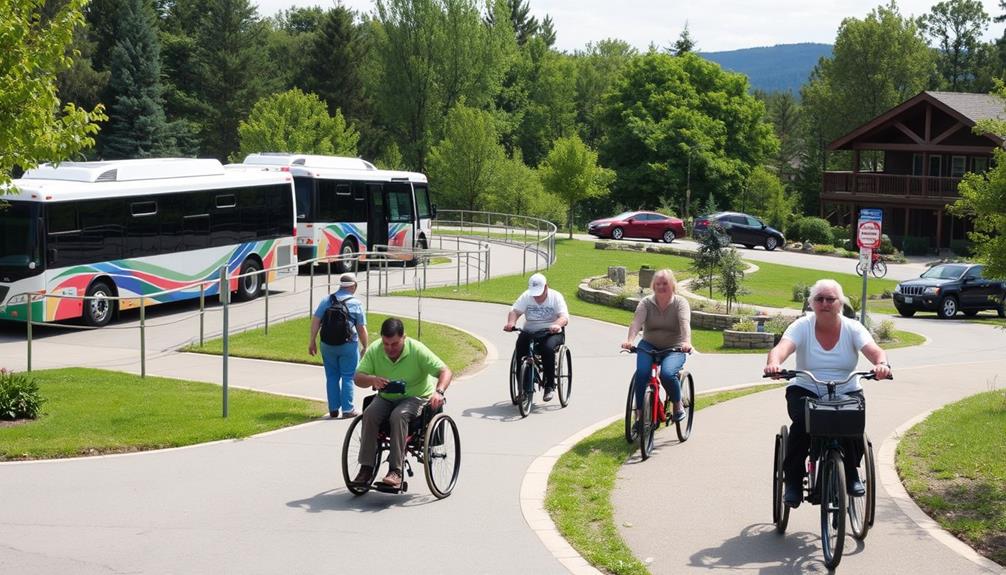
Guaranteeing accessible transportation options is crucial for making your retreat center welcoming to everyone. To achieve true transportation accessibility, you need to offer shuttle services and public transport that include wheelchair ramps and designated spaces for individuals using mobility aids.
Collaborate with local transportation providers to guarantee they've accessible vehicles that can accommodate a variety of needs, such as those requiring larger wheelchair spaces or lifts.
It's also essential to provide clear signage and information about accessible transport routes and schedules at your retreat center. This helps guests know their options before they arrive.
Designate drop-off and pick-up points that are easily accessible and close to main entrances. This minimizes the distance individuals with disabilities must travel.
Additionally, implement a pre-booking system for accessible transportation services, allowing guests to arrange their travel needs in advance. This way, you're guaranteeing equal access and a smoother experience for everyone.
Staff Training and Sensitivity

Effective staff training is essential for fostering an inclusive environment at your retreat center. By equipping your team with the right knowledge and skills, you make certain that all participants feel welcome and supported.
Here are four key components to include in your staff training program:
- ADA Compliance: Educate staff on the Americans with Disabilities Act (ADA) to help them understand legal requirements and best practices for accommodating individuals with disabilities.
- Sensitivity Training: Implement modules addressing the diverse needs of individuals with various disabilities, covering physical, cognitive, and sensory challenges they may encounter.
- Role-Playing Scenarios: Create opportunities for staff to practice responding to specific accessibility needs through role-playing, boosting their confidence and preparedness to assist participants effectively.
- Communication Skills: Emphasize respectful interaction with individuals with disabilities, including understanding how to engage with assistive devices and ensuring clear communication.
Regular refreshers on accessibility standards and practices can keep your team informed of evolving best practices.
Innovative Technology for Accessibility

In today's world, innovative technology plays an essential role in making retreat centers more accessible for everyone. Automated doors and smart systems enhance the user experience, providing seamless access for individuals with disabilities. These features allow guests to navigate freely without the need for assistance, promoting independence.
Wayfinding apps are increasingly popular, guiding individuals with disabilities through the retreat environment so they can easily locate facilities and activities. This empowers guests to explore on their own terms.
Additionally, assistive technologies like speech recognition software and hearing aids enable participation for those with physical, cognitive, hearing, and visual disabilities, ensuring everyone can engage fully in retreat activities.
Moreover, augmented and virtual reality tools create immersive experiences tailored to diverse abilities, enhancing engagement and enjoyment. These technologies not only enrich the experience but also foster inclusivity.
Creating a Welcoming Environment
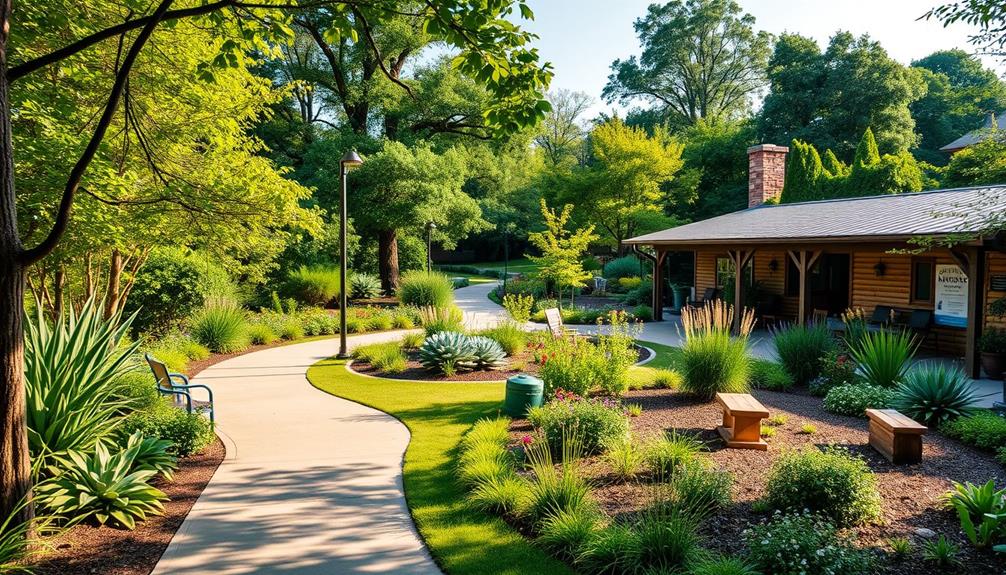
Creating an inviting atmosphere is just as important as incorporating innovative technology for accessibility. To foster a sense of belonging for all individuals, you need to take into account various aspects of the environment.
Here are four essential elements to include:
- Universal Design Principles: Implement wide doorways, ramps, and elevators to guarantee everyone can easily navigate the space, regardless of mobility.
- Clear Signage: Use intuitive signage with braille and large print to enhance wayfinding for individuals with visual impairments or cognitive disabilities.
- Sensory-Friendly Spaces: Create quiet rooms and calming areas to accommodate those with sensory processing sensitivities or mental health needs, allowing them a peaceful retreat when needed.
- Flexible Seating Arrangements: Design common areas, like dining facilities and activity rooms, with adaptable seating to cater to diverse physical needs and preferences.
Frequently Asked Questions
What Are Common Misconceptions About Designing Accessible Spaces?
You might think accessibility only concerns those with disabilities, but it actually benefits everyone. Many overlook that designing for various needs enhances usability, and accessibility doesn't always mean sacrificing aesthetics or functionality.
How Can I Assess Accessibility Needs Before Construction?
To assess accessibility needs before construction, observe diverse user experiences, conduct surveys, and engage with community members. Prioritize feedback, identify barriers, and guarantee inclusive design principles guide your planning process for maximum accessibility.
What Materials Are Best for Accessible Design?
When considering materials for accessible design, you'll want to choose non-slip flooring, lightweight but sturdy furniture, and durable, easy-to-clean surfaces. These options enhance safety and comfort, ensuring everyone can enjoy the space without barriers.
How Can I Involve the Community in the Design Process?
You can involve the community by hosting workshops, gathering feedback through surveys, and encouraging open discussions. Engaging local advocates and potential users guarantees diverse perspectives, making your design more inclusive and reflective of everyone's needs.
What Are Some Examples of Successful Accessible Retreat Centers?
Have you ever visited an accessible retreat center? Places like the Serenity Retreat and Harmony Haven showcase inclusive designs, featuring wheelchair ramps, sensory gardens, and adaptive facilities, making them perfect for everyone to enjoy a rejuvenating experience.
Conclusion
Designing an accessible retreat center isn't just about ramps and elevators; it's about embracing the beauty of diversity. You'd think creating a welcoming space for all would be easy, yet it's often overlooked. But by prioritizing inclusivity, you're not just checking boxes—you're opening doors to transformative experiences. So, while some might see accessibility as a burden, you'll know it's a blessing, inviting everyone to share in the serenity and connection that retreats promise.
- About the Author
- Latest Posts
Introducing Ron, the home decor aficionado at ByRetreat, whose passion for creating beautiful and inviting spaces is at the heart of his work. With his deep knowledge of home decor and his innate sense of style, Ron brings a wealth of expertise and a keen eye for detail to the ByRetreat team.
Ron’s love for home decor goes beyond aesthetics; he understands that our surroundings play a significant role in our overall well-being and productivity. With this in mind, Ron is dedicated to transforming remote workspaces into havens of comfort, functionality, and beauty.
Retreat
DIY Natural Cleaning Products for Your Home or Retreat Center
Create your own eco-friendly cleaning products that boost air quality and save money—discover simple recipes that will transform your cleaning routine!
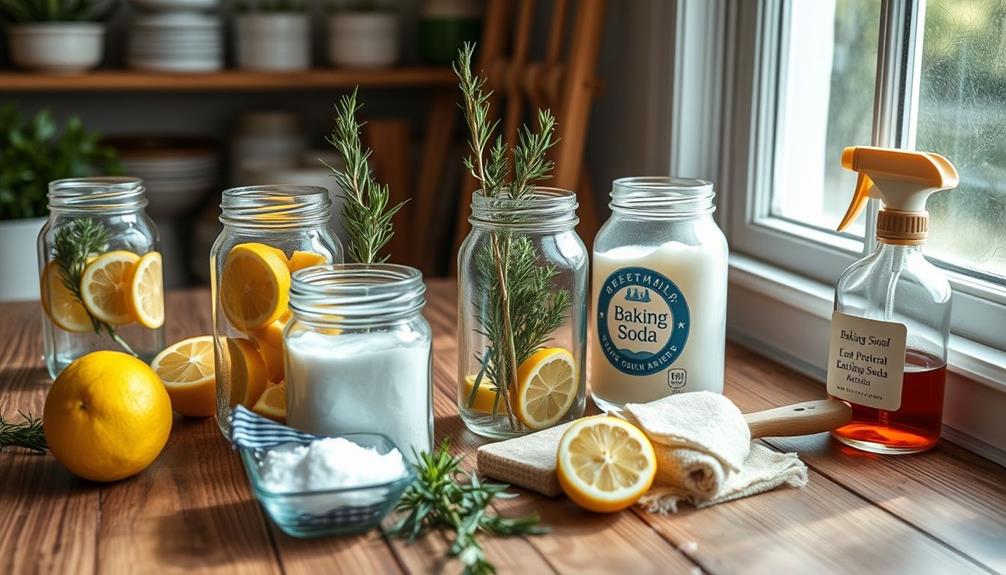
You can create DIY natural cleaning products for your home or retreat center using simple ingredients like vinegar, baking soda, and essential oils. These eco-friendly solutions eliminate harmful toxins, improve air quality, and save you money. For an all-purpose cleaner, mix half a cup of vinegar with two tablespoons of baking soda in a spray bottle. You'll find options for every area, from kitchens to bathrooms and laundry. Plus, you're doing your part for the environment by reducing plastic waste. If you want more recipes and tips for effective cleaning, there's much more to explore.
Key Takeaways
- Natural cleaners eliminate harmful toxins, improve air quality, and promote a healthier environment for homes and retreat centers.
- Essential ingredients like vinegar, baking soda, and castile soap create effective and eco-friendly cleaning solutions.
- Simple recipes, such as all-purpose cleaner and soft-scrub paste, make DIY cleaning easy and cost-effective.
- Fabric fresheners and carpet refreshers can be created using common pantry items for odor control and cleanliness.
- Storing homemade cleaners in glass containers ensures safety and longevity while avoiding chemical reactions.
Benefits of Natural Cleaners

When it comes to cleaning your home, opting for natural cleaners offers a range of benefits that go beyond just a tidy space. By using homemade cleaning solutions, you eliminate harmful toxins and chemicals commonly found in commercial products, improving your indoor air quality. This change reduces health risks associated with chemical exposure, making your home a safer place.
Additionally, many natural ingredients, like vinegar and baking soda, can be paired with used coffee grounds to create effective scrubs for tough stains, enhancing your cleaning routine through innovative coffee gear and accessories.
Natural cleaners, like vinegar and baking soda, are often more cost-effective than their commercial counterparts. You can save money over time by utilizing common pantry ingredients.
Plus, many of these natural ingredients possess antimicrobial properties, allowing you to disinfect surfaces effectively without compromising your health or the environment.
Choosing natural options also promotes sustainability. You reduce plastic waste from commercial products while minimizing harmful chemicals that can pollute waterways.
With customizable recipes, you can tailor your cleaning solutions to meet your specific needs and preferences, enhancing your overall cleaning experience. Whether you prefer the scent of certain essential oils or have sensitivities to specific ingredients, you can create a solution that works for you.
Embracing natural cleaners not only supports your health but also contributes to a healthier planet.
Kitchen Cleaning Recipes

When it comes to kitchen cleaning, you'll want to know the essential ingredients that can help you create effective solutions.
Utilizing natural products can't only enhance the cleanliness of your kitchen but also provide a healthier environment, similar to how coffee can enhance performance during workouts.
We've got some simple recipes that make tackling messes a breeze, plus tips for getting the most out of your homemade cleaners.
Let's get started on transforming your kitchen with natural products!
Essential Ingredients Overview
Understanding the essential ingredients for your DIY kitchen cleaning recipes can make a significant difference in your cleaning routine. By using natural cleaning products, you can create effective homemade cleaners that are both eco-friendly and safe for your family. Here are the key ingredients to examine:
| Ingredient | Benefits |
|---|---|
| Vinegar | Cuts through grease and neutralizes odors, making it a versatile all-purpose cleaner. |
| Baking Soda | Acts as a natural abrasive, removes stains and odors, especially when combined with vinegar. |
| Essential Oils | Adds natural disinfectant properties and pleasant fragrances for an enhanced cleaning experience. |
| Disinfectant Wipes | Soaked cloth squares provide quick and effective surface cleaning. |
Mixing 1/2 cup of vinegar, 2 tablespoons of baking soda, and a few drops of essential oils in a spray bottle creates a powerful all-purpose cleaner. For disinfectant wipes, soak cloth squares in a solution of 1 cup water, 1/4 cup vinegar, and essential oils. With these ingredients, you'll have the tools you need for effective and natural surface cleaning in your kitchen!
Effective Cleaner Recipes
Creating your own effective cleaning products can transform your kitchen into a sparkling, chemical-free space. Start with an all-purpose cleaner by mixing 1/2 cup of vinegar, 2 tablespoons of baking soda, and a few drops of your favorite essential oils in a spray bottle. This versatile solution tackles everyday cleaning with ease while also ensuring a healthier environment, akin to the benefits of using an air purifier for improved air quality.
For tougher messes, whip up a soft-scrub cleaner. Combine 1.5 cups of baking soda with 1/2 cup of liquid laundry soap and some essential oils to form a paste. This natural scrub will help you tackle grime without harsh chemicals.
If you're looking for a convenient way to sanitize surfaces, make disinfectant wipes by soaking cloth squares in a mix of 1 cup of water, 1/4 cup of vinegar, and essential oils. These eco-friendly wipes are perfect for quick clean-ups.
Don't forget about the dishes! Create a natural liquid dish soap by mixing 1/2 cup of distilled water, 1/2 cup of vinegar, and 1/2 cup of Dr. Bronner's Sal Suds.
For your homemade dishwasher detergent, blend 1 cup of salt, 2 cups of baking soda, 2 cups of Borax, and 1 cup of Lemi-Shine. Enjoy your clean kitchen!
Tips for Optimal Use
To get the most out of your DIY natural cleaning products, it's essential to use them correctly and efficiently.
Start with an all-purpose cleaner by mixing 1/2 cup of vinegar, 2 tablespoons of baking soda, and a few drops of essential oils, such as essential oils for respiratory health, in a spray bottle. Shake it well before each use to guarantee effectiveness.
For tough kitchen grime, create a soft-scrub cleaner using 1.5 cups of baking soda, 1/2 cup of liquid laundry soap, and essential oils to form a paste.
If you want quick disinfectant wipes, soak cloth squares in a solution of 1 cup water, 1/4 cup vinegar, and essential oils, and store them in a sealed container for easy access.
For a natural dish soap alternative, mix 1/2 cup distilled water, 1/2 cup vinegar, and 1/2 cup Dr. Bronner's Sal Suds.
Lastly, enhance your dishwasher's performance by combining 1 cup of salt, 2 cups of baking soda, 2 cups of Borax, and 1 cup of Lemi-Shine for a homemade detergent that tackles tough stains.
Following these cleaning tips will help you maximize the power of natural alternatives in your home.
Bathroom Cleaning Solutions

When it comes to keeping your bathroom fresh and clean, natural cleaning solutions can be both effective and simple to make. For a powerful toilet bowl cleaner, consider using Kool-Aid lemonade. Its citric acid properties work wonders to clean and deodorize, similar to how cold medications can provide effective relief.
For a streak-free shine on mirrors and glass, mix 1/4 cup vinegar, 1/4 cup rubbing alcohol, 1 tablespoon cornstarch, and 2 cups water.
If you prefer disinfectant wipes, soak cloth squares in a combination of 1 cup water, 1/4 cup vinegar, and your favorite essential oils. This makes for convenient cleaning of surfaces.
To tackle mildew, use a mildew cleaner made from vinegar, castile soap, and essential oils.
For a homemade all-purpose cleaner, try combining baking soda with vinegar; just remember not to mix them in closed containers to avoid overflow.
These natural cleaning solutions not only keep your bathroom sparkling but also help create a healthier environment. With these simple recipes, you can easily maintain a clean and inviting space without harsh chemicals.
Laundry Room Recipes

When it comes to laundry, you can easily create effective solutions for stain removal, eco-friendly detergents, and fabric fresheners right at home.
Incorporating essential oils for skin conditions can't only help with stains but also keep your fabrics smelling delightful.
With simple ingredients like vinegar, baking soda, and essential oils, you can tackle tough stains and keep your clothes smelling fresh.
Let's explore some easy recipes that will transform your laundry routine!
Effective Stain Removal Techniques
Effective stain removal techniques are essential for keeping your laundry looking fresh and clean. With a few DIY cleaning products, you can tackle tough stains without harsh chemicals.
Additionally, consider incorporating eco-friendly practices into your routine, such as using materials from sustainable sources, much like the innovative designs found in unique planter styles.
Here are some effective methods:
- Baking Soda Paste: Mix baking soda with water to create a paste. Apply it to the stain and let it sit for 30 minutes before rinsing.
- Vinegar and Baking Soda Combo: Combine 1 cup of vinegar with 1 cup of baking soda to fight stubborn odors and stains. Soak for 15-30 minutes before washing.
- Lemon Juice: For fresh stains on white fabrics, apply lemon juice directly to the stain and let it sun-bleach for a natural lift.
You can also use hydrogen peroxide for stains like wine or blood. Just apply it directly, let it sit for 5-10 minutes, and rinse.
For a gentle pre-treatment, mix 1/4 cup of liquid castile soap with 1 cup of water to create a stain remover.
With these natural cleaners, you'll keep your laundry looking great while using safe and effective cleaning recipes.
Eco-Friendly Laundry Detergent Recipes
Creating your own eco-friendly laundry detergent not only saves money but also reduces your impact on the environment, allowing you to engage in innovative problem-solving processes while taking care of your home.
With simple ingredients, you can whip up effective homemade solutions that keep your clothes fresh and clean.
For a basic homemade liquid laundry detergent, mix 1/2 cup Borax, 1/2 cup washing soda, and 1/2 cup Dawn dish soap in 4 cups of hot water. This eco-friendly blend is powerful and cost-efficient.
If you prefer a natural alternative, try soap nuts, which contain saponin and are biodegradable. You can reuse them multiple times before composting.
To brighten whites without harsh chemicals, create a natural bleach alternative by combining 1 gallon of hot water with 1 tablespoon of castile soap and 2 tablespoons of hydrogen peroxide.
For a softener, simply add 1 cup of vinegar during the rinse cycle. This natural softener not only helps eliminate static cling but also softens your clothes, avoiding synthetic additives.
With these recipes, you'll enjoy effective at cleaning your laundry while being kind to the environment. Embrace these natural solutions and transform your laundry routine today!
Fabric Freshening Solutions
A few simple ingredients can transform your laundry routine with homemade fabric freshening solutions that effectively eliminate odors and leave your fabrics smelling great.
These natural cleaning recipes not only freshen up your items but also promote healthier living by avoiding harsh chemicals. Implementing these methods can be likened to the importance of quality assurance in software development, as both guarantee high standards and user satisfaction ensures software meets high-quality standards.
To create a basic fabric freshener, mix equal parts of distilled water and white vinegar in a spray bottle, adding 10-20 drops of your favorite essential oil. This combination works wonders for absorbing odors.
You can also enhance your freshener by including baking soda, which is particularly effective for upholstery and carpets.
Here are a few more ideas for fabric fresheners:
- Odor Neutralizer: Combine 1 cup of water, 1 tablespoon of vodka, and 10 drops of essential oil.
- Scent Booster: Mix 1 cup of Epsom salt with 10-15 drops of essential oil and let it sit for a day before adding it to your wash.
- Carpet Refresher: Create a baking soda mixture with essential oils to sprinkle on carpets before vacuuming.
With these homemade solutions, you'll enjoy fresher fabrics without compromising your health!
Living Area Cleaners
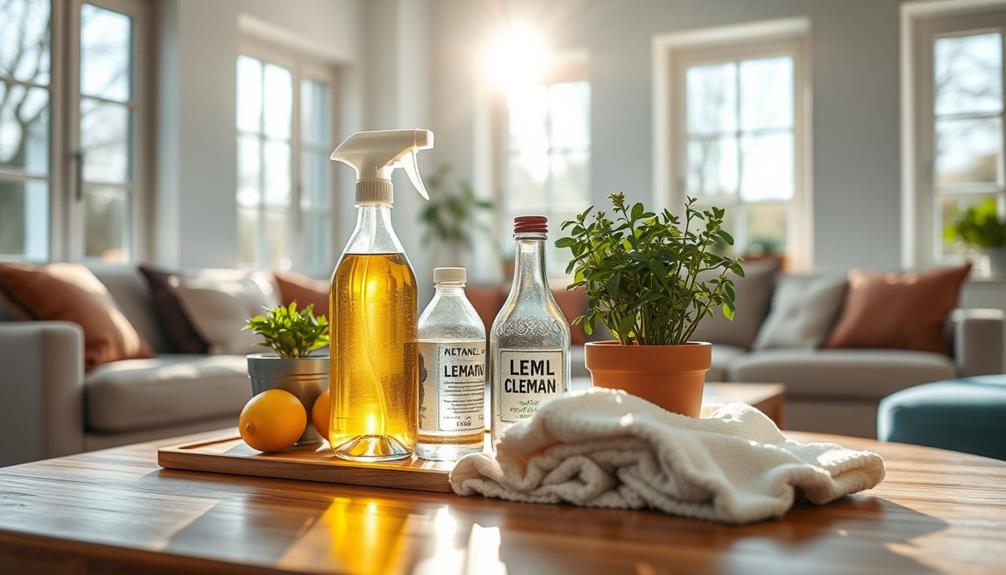
Keeping your living area fresh and clean doesn't have to involve harsh chemicals. You can create your own natural cleaners that effectively tackle dirt and odors. One great option is a dusting spray made from 1 tablespoon of castile soap, 15 drops of lemon essential oil, and 2 cups of water in a spray bottle. This cleaner not only cleans surfaces but also leaves a revitalizing scent.
Additionally, maintaining a clean environment can contribute to your overall financial health by reducing the need for costly commercial cleaning products, making it a wise financial choice.
For polishing wooden furniture, mix 3/4 cup of olive oil with 1/4 cup of white vinegar, adding 30 drops of essential oil if you like. This wood polishing spray nourishes and protects without harmful chemicals.
If your carpets need a renewal, try a carpet freshener made from 2 cups of Borax, 1 cup of baking soda, and 10 drops of essential oil. Sprinkle it on before vacuuming to absorb odors.
For tough stains, start with baking soda and follow up with a mixture of Dawn dish soap, vinegar, and warm water to lift those pesky marks.
Incorporating essential oils into your living area cleaners not only enhances the scent but also adds antibacterial properties, making your home a healthier space.
Essential Ingredients for Cleaners
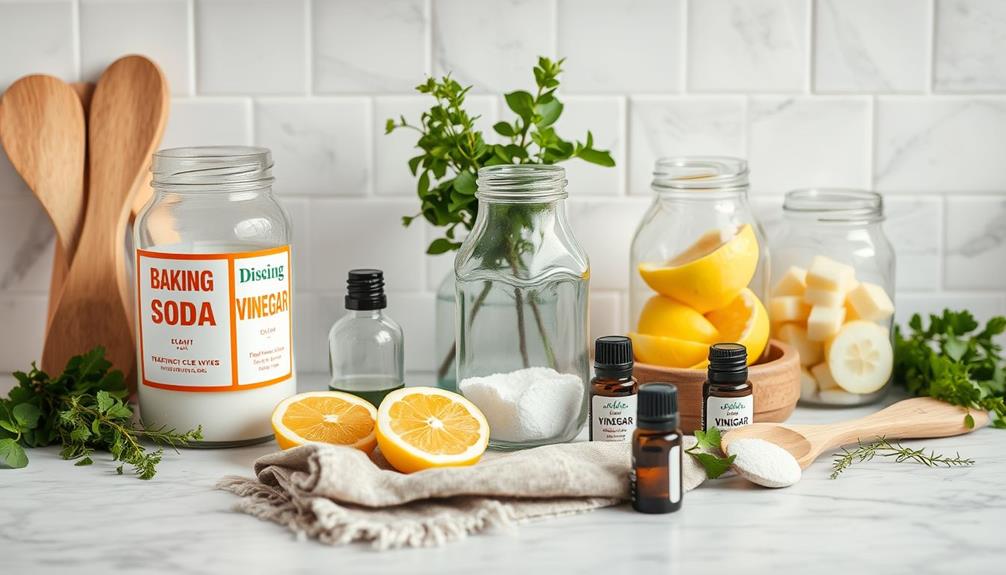
What essential ingredients can elevate your natural cleaning routine? Incorporating a few key elements can transform your DIY cleaners into powerful, effective solutions. Here are three essential ingredients to take into account:
- Vinegar: This versatile natural disinfectant cuts through grease, removes hard water stains, and deodorizes surfaces without the use of harmful chemicals.
- Baking Soda: A mild abrasive, baking soda absorbs odors and removes stains. When combined with vinegar, it creates a potent cleaning spray for tougher messes.
- Castile Soap: This biodegradable, plant-based soap is safe for use around children and pets. Dilute it for various cleaning tasks, making it a fantastic choice for general cleaning purposes.
Don't forget to enhance your cleaners with essential oils like tea tree, lavender, or lemon. These oils not only add pleasant fragrances but also offer antibacterial and antifungal properties, boosting your cleaner's effectiveness.
Together, these ingredients create powerful, eco-friendly solutions to keep your home sparkling clean while being kind to the environment. With these essentials, you're well on your way to mastering DIY cleaning products!
Tips for Homemade Cleaners
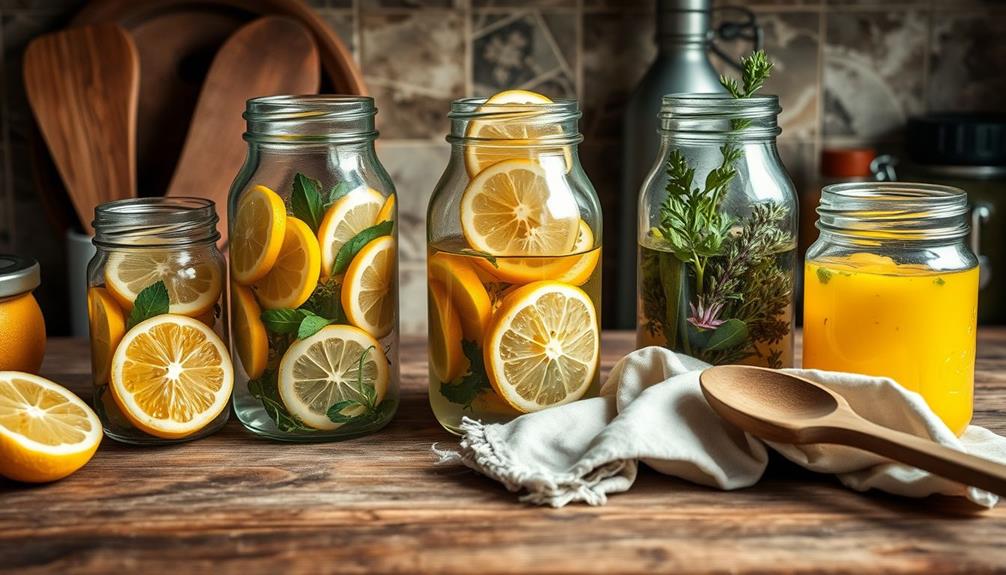
When you're making homemade cleaners, safe storage is just as important as using the right ingredients.
Experimenting with different combinations can lead to effective new solutions, but always test them on small areas first.
Safe Storage Practices
Storing homemade cleaners safely is essential for maintaining their effectiveness and guaranteeing your family's safety. Using the right storage practices can help you avoid accidents and keep your cleaning products potent.
Here are some tips to follow:
- Use glass containers: Glass or recycled containers are best for storing homemade cleaners. They prevent chemical reactions and don't leach harmful substances, unlike plastic.
- Label cleaning products: Clearly label all your homemade cleaners with their contents and the date of preparation. This helps you avoid confusion and guarantees proper usage.
- Keep out of reach: Always store cleaning solutions out of reach of children and pets to prevent accidental ingestion or contact with potentially harmful ingredients.
For powders like baking soda, use airtight containers to prevent moisture absorption, which can lead to clumping and reduced effectiveness.
Regularly check the potency of your homemade cleaners, especially those containing vinegar and essential oils, as they can lose their effectiveness over time.
Ingredient Experimentation Tips
Keeping your homemade cleaners effective goes hand in hand with experimenting with different ingredients. Start by adjusting the ratios of vinegar and water to find the ideal cleaning strength for various surfaces. Vinegar solutions can be tailored to your specific cleaning tasks, making them versatile and efficient.
When using baking soda, remember that it can clog spray bottles. Instead, consider using it in a paste form or mix it with water before application for a smoother experience. Essential oils can elevate your natural cleaning products not only by adding fragrance but also by providing antibacterial properties. Just be cautious about the types of oils you choose, especially if you have pets.
Always test your homemade cleaners on small, inconspicuous areas before applying them widely. This helps you avoid damaging any surfaces or fabrics.
Regularly experiment with ingredients like hydrogen peroxide, castile soap, and lemon juice to discover more effective cleaning solutions tailored to your preferences. By mixing and matching these components, you'll create a lineup of homemade cleaners that work best for your home or retreat center. Happy experimenting!
Environmental Impact and Awareness
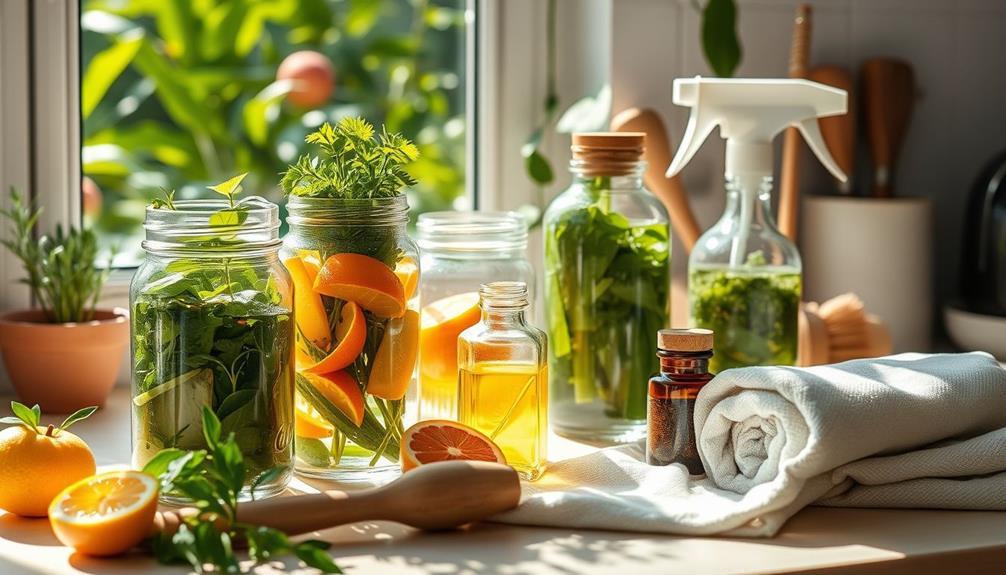
The choice to use DIY natural cleaning products plays an essential role in fostering environmental awareness and reducing our ecological footprint. When you opt for homemade cleaners, you greatly lower household toxins and chemicals, which contributes to improved indoor air quality and a healthier living environment.
By using natural ingredients like vinegar, baking soda, and essential oils, you also tackle plastic waste, minimizing the need for single-use commercial cleaning product packaging.
Consider these benefits of switching to eco-friendly cleaners:
- Biodegradable: They break down quickly, reducing pollution in waterways.
- Healthier choices: Using natural ingredients promotes sustainable living, benefiting both your health and the environment.
- Cost-effective: DIY cleaning solutions save you money while giving you control over what you use.
Community Engagement in Cleaning
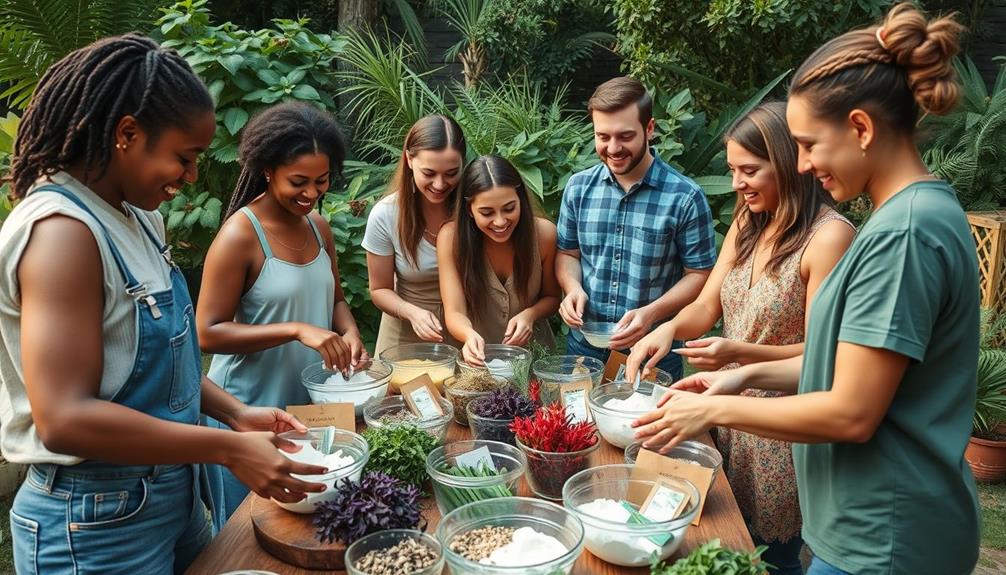
Community involvement in natural cleaning practices creates a vibrant exchange of ideas and experiences. When you engage with others in a community setting, you'll find that recipe sharing becomes a cornerstone of collaborative learning. This supportive environment enhances your understanding of homemade products and eco-friendly cleaning methods.
As you discuss your experiences with DIY cleaners, you'll uncover common challenges that many face. This opens the door for collective problem-solving, leading to improved cleaning methods and natural scouring techniques.
You'll appreciate the emphasis on ingredient transparency, as community members advocate for awareness of the health and environmental impacts of the products you choose to use.
Ingredient substitutions and customization are frequently explored, allowing you to adapt recipes to suit your specific needs. This fosters creativity in your cleaning solutions, making the process not only effective but also enjoyable.
Experimenting With Recipes
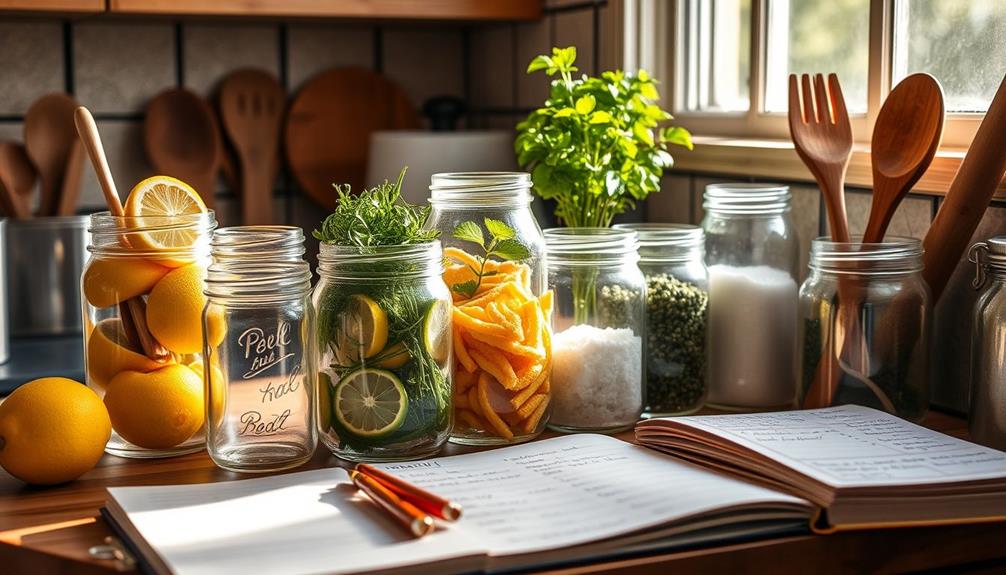
Building on the shared knowledge from community discussions, experimenting with different DIY cleaning recipes can lead to effective and personalized solutions for your home. By adjusting ratios of vinegar, baking soda, and essential oils, you'll discover the most effective homemade cleaner tailored to your specific needs.
Here are a few tips to enhance your natural cleaning journey:
- Start with small batches to minimize waste and easily adjust based on cleaning efficacy.
- Use a simple vinegar and water solution for general cleaning, as it often outperforms baking soda and vinegar mixtures.
- Customize your recipes—try adding tea tree oil for its antifungal properties when tackling mold and mildew.
Documenting the results of each experiment is vital. It helps you identify what combinations work best for different tasks, refining your natural cleaning arsenal over time.
Frequently Asked Questions
How Do You Make Holistic Cleaning Products?
To make holistic cleaning products, you can mix equal parts water and vinegar for an all-purpose cleaner. Enhance it with essential oils. Experiment with combinations to find what works best for your needs and preferences.
How to Make Homemade Multi-Purpose Cleaner?
You'd think making a multi-purpose cleaner is complicated, but it's not! Just mix equal parts water and vinegar, add essential oils, and a teaspoon of castile soap. Shake, spray, and watch dirt disappear!
What Is the Best Natural Thing to Clean With?
The best natural cleaner is vinegar. It effectively kills germs and deodorizes surfaces. Combine it with baking soda for tough stains, or use lemon juice for grease. These options are safe, eco-friendly, and versatile for your needs.
How Can I Deep Clean My House Naturally?
When it comes to deep cleaning your house naturally, think of it as a revitalizing spring rain washing away the grime. Mix vinegar and water, or use baking soda paste for stubborn stains. Enjoy the transformation!
Conclusion
By embracing DIY natural cleaning products, you're not just sprucing up your home; you're transforming it into a fragrant oasis, where every surface sparkles like the sun on a summer's day! Imagine a kitchen that smells like a citrus grove and a living room infused with the freshness of wildflowers. You're not just cleaning; you're creating a sanctuary of health and happiness. So grab those ingredients, release your inner cleaning wizard, and watch your home bloom into a purifying paradise!
- About the Author
- Latest Posts
Introducing Ron, the home decor aficionado at ByRetreat, whose passion for creating beautiful and inviting spaces is at the heart of his work. With his deep knowledge of home decor and his innate sense of style, Ron brings a wealth of expertise and a keen eye for detail to the ByRetreat team.
Ron’s love for home decor goes beyond aesthetics; he understands that our surroundings play a significant role in our overall well-being and productivity. With this in mind, Ron is dedicated to transforming remote workspaces into havens of comfort, functionality, and beauty.
-

 Retreat1 week ago
Retreat1 week agoDIY Aromatherapy Diffusers for a Spa-Like Atmosphere at Home
-

 Retreat2 weeks ago
Retreat2 weeks agoThe Profitability of Retreat Centers: A Financial Analysis
-

 Retreat2 weeks ago
Retreat2 weeks agoUnusual DIY Projects: Designing a Space Probe in Bitlife
-

 Retreat2 weeks ago
Retreat2 weeks agoComprehensive Review: Are Home Decorators Ceiling Fans Worth the Investment?
-

 Retreat1 week ago
Retreat1 week agoThe Psychology of Color in Retreat Center Design
-

 Southeast Asia Decor4 days ago
Southeast Asia Decor4 days agoIndonesian Textiles Shaping Contemporary Interior Design
-

 Retreat2 weeks ago
Retreat2 weeks agoHow to Create a Zen Garden for Your Retreat Center
-

 Retreat2 weeks ago
Retreat2 weeks agoIs Opening a Home Decor Store Profitable in 2024?











